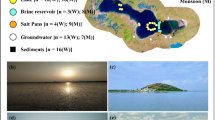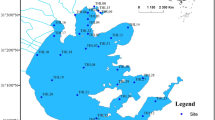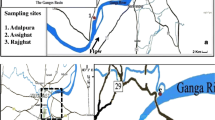Abstract
Recent measurements have demonstrated unprecedented increase in atmospheric deposition of nutrients in many parts of India. To determine whether atmospheric nutrient inputs would increase phytoplankton growth and catchment dissolved organic carbon (DOC) flushing to constrain benthic algae, we analyzed NO3 − and PO −34 in atmospheric deposits; nutrients and DOC in runoff and lake water and standing crop biomass of phytoplankton and periphyton at Jaisamand Lake of Rajasthan, India. Atmospheric deposition of NO3 − (7.18–29.95 kg ha−1 year−1) and PO −34 (0.56–2.15 kg ha−1 year−1) showed a consistently rising trend across the year. Microbial biomass and activity in catchment increased in response to atmospheric deposition. Lake DOC and nutrients showed strong coherence with their terrestrial and atmospheric fluxes. Phytoplankton development showed significant linearity with atmospheric input of nutrients. Air-driven input appeared to have compensated the nutrient constraints to phytoplankton during drought. The N:P stoichiometry of deposition and that of lake water indicated that, although there was a seasonal switchover to N- or P-limitation, phytoplankton were mainly co-limited by N and P due probably to the synergistic effects of combined N + P enrichment in the pelagic zone of the lake. Periphyton standing crop showed inverse relationship with phytoplankton and lake DOC. The study indicated that enhanced phytoplankton development and terrestrial DOC flushing in response to atmospheric nutrient input attenuated light penetration to constrain algal periphyton. We suggests that data on these issues may be considered in developing aquatic ecosystem models to establish future links between changing air–water–land interactions and associated shifts in lake ecosystem functioning for more accurately predicting climate change drivers and designing integrated lake basin management strategies.







Similar content being viewed by others
References
American Public Health Association (1998) Standard methods for the examination of water and wastewater. APHA, Washington, DC
Anderson JPE, Domsch KH (1978) A physiologically active method for the quantitative measurement of microbial biomass in soils. Soil Biol Biochem 10:215–221
Beer S, Eshel A (1985) Determining phycoerythrin and phycocyanin concentrations in aqueous crude extracts of red algae. Aust J Mar Freshwat Res 36:785–792
Bergstrom AK, Jansson M (2006) Atmospheric nitrogen deposition has caused nitrogen enrichment and eutrophication of lakes in the northern hemisphere. Global Change Biol 12:635–643
Bergstrom AK, Jansson M, Blomqvist P, Drakare S (2001) The influence of water colour and effective light climate on mixotrophic phytoflagellates in three small Swedish dystrophic lakes. Int Assoc Theor Appl Limnol 27:1861–1865
Bergstrom AK, Blomqvist P, Jansson M (2005) Effects of atmospheric nitrogen deposition on nutrient limitation and phytoplankton biomass in unproductive Swedish lakes. Limnol Oceanogr 50:987–993
Bergstrom AK, Jonsson A, Jansson M (2008) Phytoplankton responses to nitrogen and phosphorus enrichment in unproductive Swedish lakes along a gradient of atmospheric nitrogen deposition. Aquat Biol 4:55–64
Bobbink KR, Lamers LPM (2002) Effects of increased nitrogen deposition. In: Bell JNB, Treshow M (eds) Air pollution and plant life. Wiley, New York, pp 202–235
Carey RO, Vellidis G, Lowrance R, Pringle CM (2007) Do nutrient limit algal periphyton in small black-water coastal plain streams. J Am Water Resour Assoc 5:1183–1193
Chen N, Hong H (2011) Nitrogen export by surface runoff from a small agricultural watershed in southeast China: seasonal patterns and primary mechanisms. Biogeochemistry 106:311–321
Christensen KK, Andersen FO, Jensen HS (1997) Comparison of iron, manganese and phosphorus retention in freshwater littoral sediment with growth of Littorella uniflora and benthic microalgae. Biogeochemistry 38:149–171
Eimers MC, Watmough SA, Buttle JM (2008) Long term trends in dissolved organic carbon concentration: a cautionary note. Biogeochemistry 87:71–81
Elser JJ, Fafan WF, Denno RF, Dobberfuhl DR, Folorin A, Huberty A, Interlandi S, Kilham SS, Mecauley E, Schulz KL, Siemann EH, Sterner RW (2000) Nutritional constraints in terrestrial and freshwater foodwebs. Nature 408:578–580
Elser JJ, Andersen T, Baron JS, Bergstrom AK, Jansson M, Kyle M, Nydick KR, Steger L, Hessen DO (2009) Shifts in lake stoichiometry and nutrient limitation driven by atmospheric nitrogen deposition. Science 326:835–837
Evans CD, Chapman PJ, Clark JM, Monteith DT, Cresser MS (2006) Alternative explanations for rising dissolved organic carbon export from organic soils. Global Change Biol 12:2044–2053
Jansson M, Bergstrom AK, Blomqvist P, Drakare S (2000) Organic carbon and phytoplankton/bacterioplankton production relationships in lakes. Ecology 82:3250–3255
Kaczmarezyk D, Sheath RG (1991) The effect of light regime on the photosynthetic apparatus of the freshwater red alga Batrachospermum boryanum. Crypto Algol 12:249–263
Kalbitz K, Solinger S, Park J-H, Michalzik B, Matzner E (2000) Control on the dynamics of dissolved organic matter in soils: a review. Soil Sci 165:277–304
Karlsson J, Bystrom P, Ask J, Ask P, Persson L, Jansson M (2009) Light limitation of nutrient-poor lake ecosystems. Nature 460:506–509
Kirchman DL, Suzuki Y, Garside C, Ducklow HW (1991) High turnover rates of dissolved organic carbon during a spring phytoplankton bloom. Nature 352:612–614
Krivtsov V, Siegee D, Bellinger E (2001) A one year study of the Rostherne Mere ecosystem: seasonal dynamics of water chemistry, plankton, internal nutrient release and implications for long term trophic status and overall functioning of the lake. Hydrol Process 15:10–17
Lobo V (2008) Characterization of Jaisamand Lake and its implication for management. In: Sengupta M, Dalwani R (eds) Proceedings Taal 2007: the 12th world lake conference, Jaipur, India, pp 1542–1556
Lohse KA, Hope D, Sponseller R, Allen JO, Grimm NB (2008) Atmospheric deposition of carbon and nutrients across an arid metropolitan area. Sci Tot Environ 402:95–105
Luijn FV, van der Molen DT, Luttmer WJ, Boers PCM (1995) Influence of benthic diatoms on the nutrient release from sediments of shallow lakes recovering from eutrophication. Water Sci Technol 32:89–97
Mackereth FJH (1963) Some methods of water analysis for limnologists. Scientific publication no 21. Freshwater Biological Association, Ambleside
Maiti SK (2001) Handbook of methods in environmental studies, vol 1. Water and wastewater. ABD Publisher, Jaipur, India
McEachern P, Prepas EE, Gibson JJ, Dinsmore WP (2000) Forest fire induced impacts on phosphorus, nitrogen and chlorophyll a concentrations in boreal subarctic lakes of northern Alberta. Can J Fish Aquat Sci 57:73–81
Michel P (1984) Ecological Methods for field and laboratory investigation. Tata McGraw-Hill Publ Comp, New Delhi, India
Monteith DT, Stoddard JL, Evans CD, de Wit HA, Forsius M, Hogasen T, Wilander A, Skjelkvale BL, Jeffries DS, Vuorenmma J, Keller B, Kopacek J, Vesely J (2007) Dissolved organic carbon trends resulting from changes in atmospheric deposition chemistry. Nature 450:537–541
O’ Reilly CM (2006) Seasonal dynamics of periphyton in a large tropical lake. Hydrobiologia 553:293–301
Pandey J (2011) The influence of atmospheric deposition of pollutant elements on cross-domain causal relationships at three tropical freshwater lakes of India. Lakes Reserv Res Manag 16:111–119
Pandey J, Pandey U (2001) The influence of catchment on ecosystem properties of a tropical freshwater lake. Biotronics 30:85–92
Pandey J, Pandey U (2009) Microbial processes at land water interface and cross-domain causal relationships as influenced by atmospheric deposition of pollutants in three freshwater lakes in India. Lakes Reserv Res Manag 14:71–84
Perakis SS, Hedin LO (2002) Nitrogen loss from unpolluted South American forests mainly via dissolved organic compound. Nature 145:416–419
Porcal P, Koprivnjak JF, Molot LA, Dillon PJ (2009) Humic substances-part 7: the biogeochemistry of dissolved organic carbon and its interactions with climate change. Environ Sci Pollut Res Int 16:714–726
Schipper LA, Dodd MB, Fisk LM, Power IL, Parenzee J, Arnold G (2011) Trends in soil carbon and nutrients of hill-country pastures receiving different phosphorus fertilizer loadings for 20 years. Biogeochemistry 104:35–48
Singh KP, Tripathi SK (2000) Impact of environmental nutrient loading on the structure and functioning of terrestrial ecosystems. Curr Sci 79:316–323
Sowerby A, Emmett BA, Williams D, Beier C, Evans CD (2010) The response of dissolved organic carbon (DOC) and the ecosystem carbon balance to experimental drought in a temperate shrub land. Euro J Soil Sci 16:697–709
Tate KR, Ross DJ, Filtham CW (1998) A direct method to estimate soil microbial biomass C: effect of experimental variables on some different calibration procedure. Soil Biol Biochem 20:329–335
Tilman D, Fargione J, Wolff B, Antonia CD, Dobson A, Howarth R, Schindler D (2001) Forecasting agriculturally driven global environmental change. Science 292:281–284
Tranvik LJ, Jansson M (2002) Climate change: terrestrial export of organic carbon. Nature 415:861–862
Vadeboncoeur Y, Jeppesen E, Zanden MJV, Schierup H–H, Christoffersen K, Lodge DM (2003) From Greenland to green lakes: cultural eutrophication and the loss of benthic pathways in lakes. Limnol Oceanogr 48:1408–1418
Voghe AI (1971) A Textbook of quantitative inorganic analysis, 4th edn. The English Language Book Society/Longman, Essex
Wedin DA, Tilman D (1996) Influence of nitrogen loading and species composition on the carbon balance of grasslands. Science 274:1720–1723
Wetzel RG (2001) Limnology: lakes and river ecosystems. Academic Press, San Diego
Weyhenmeyer GA, Karlsson J (2009) Nonlinear response of dissolved organic carbon concentrations in boreal lakes to increasing temperature. Limnol Oceanogr 54:2513–2519
Worrall F, Burt TP, Adamson JK (2006) Trends in drought frequency: the fate of DOC export from British peatlands. Clim Chang 76:339–359
Yang Y, He Z, Lin Y, Phlips EJ, Yang J, Chem G, Stoffella PJ, Powell CA (2008) Temporal and spatial variations of nutrients in the Ten Mile Creek of South Florida, USA and effects on phytoplankton. J Environ Monit 4:508–516
Zade M, Ray SS, Dutta S, Panigrahy S (2005) Analysis of run-off pattern for all major basins of India derived using remote sensing data. Curr Sci 88:1301–1305
Acknowledgments
We sincerely acknowledge Prof. H. R. Tyagi, formerly Convener, Department of Environmental Science, M. L. S. University for supports identifying sites and for facilities at the first stage of the study; Prof. R. C. Tewari (Maharana Pratap University of Agriculture and Technology), for help in catchment soil processing and Dr. B. Pandey (Banaras Hindu University) for geological classification and suggestions.
Author information
Authors and Affiliations
Corresponding author
Rights and permissions
About this article
Cite this article
Pandey, U., Pandey, J. Impact of DOC trends resulting from changing climatic extremes and atmospheric deposition chemistry on periphyton community of a freshwater tropical lake of India. Biogeochemistry 112, 537–553 (2013). https://doi.org/10.1007/s10533-012-9747-7
Received:
Accepted:
Published:
Issue Date:
DOI: https://doi.org/10.1007/s10533-012-9747-7




